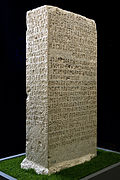A | B | C | D | E | F | G | H | CH | I | J | K | L | M | N | O | P | Q | R | S | T | U | V | W | X | Y | Z | 0 | 1 | 2 | 3 | 4 | 5 | 6 | 7 | 8 | 9
| History of Italy |
|---|
 |
|
|
| Part of a series on the |
| Culture of Italy |
|---|
 |
| People |
| Traditions |
The European country of Italy has been inhabited by humans since at least 850,000 years ago. Since classical antiquity, ancient Etruscans, various Italic peoples (such as the Latins, Samnites, and Umbri), Celts, Magna Graecia colonists, and other ancient peoples have inhabited the Italian Peninsula.[1][2]
Italy was the birthplace and centre of the ancient Roman civilisation.[3][4] Rome was founded as a kingdom in 753 BC and became a republic in 509 BC. The Roman Republic then unified Italy forming a confederation of the Italic peoples and rose to dominate Western Europe, Northern Africa, and the Near East. After the assassination of Julius Caesar, the Roman Empire dominated Western Europe and the Mediterranean for centuries, contributing to the development of Western culture, philosophy, science and art. With the fall of Rome in AD 476, Italy was fragmented into numerous city-states and regional polities, a situation that would remain until the complete unification of the country in 1871. The maritime republics, in particular Venice and Genoa, rose to prosperity.[5][6] Central Italy remained under the Papal States, while Southern Italy remained largely feudal due to a succession of Byzantine, Arab, Norman, Spanish, and Bourbon crowns.[7][8] The Italian Renaissance spread to the rest of Europe, bringing a renewed interest in humanism, science, exploration, and art with the start of the modern era.[9]
By the mid-19th century, Italian unification, led by the House of Savoy, led to the establishment of an Italian nation-state. The new Kingdom of Italy quickly modernized and built a colonial empire, controlling parts of Africa and countries along the Mediterranean. At the same time, Southern Italy remained rural and poor, originating the Italian diaspora. In World War I, Italy completed the unification by acquiring Trento and Trieste, and gained a permanent seat in the League of Nations's executive council. Italian nationalists considered World War I a mutilated victory because Italy did not have all the territories promised by the Treaty of London (1915), and that sentiment led to the rise of the fascist dictatorship of Benito Mussolini in 1922. During World War II, Italy was part of the Axis powers until the Italian surrender to Allied powers and its occupation by Nazi Germany with Fascist collaborators and then a co-belligerent of the Allies during the Italian resistance and liberation of Italy.
Following the end of the German occupation and the killing of Benito Mussolini, the 1946 Italian institutional referendum abolished the monarchy and became a republic, reinstated democracy, enjoyed an economic boom, and co-founded the European Union (Treaty of Rome), NATO, and the Group of Six (later G7 and G20).[10][11]
Prehistory

The arrival of the first hominins was 850,000 years ago at Monte Poggiolo.[12] The presence of the Homo neanderthalensis has been demonstrated in archaeological findings near Rome and Verona dating to c. 50,000 years ago (late Pleistocene). Homo sapiens sapiens appeared during the upper Palaeolithic.[13] Remains of the later prehistoric age include Ötzi the Iceman, dating to c. 3400–3100 BC (Copper Age).
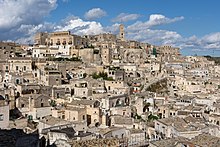
During the Copper Age, Indoeuropean people migrated to Italy in four waves. A first Indoeuropean migration occurred around the mid-3rd millennium BC, from a population who imported coppersmithing.[15] The Remedello culture took over the Po Valley. The second wave occurred in the Bronze Age, from the late 3rd to the early 2nd millennium BC, with tribes identified with the Beaker culture and by the use of bronze smithing, in the Padan Plain, in Tuscany and on the coasts of Sardinia and Sicily.[16] In the mid-2nd millennium BC, a third wave arrived, associated with the Apenninian civilization and the Terramare culture.[17][18] The Terramare people were hunters, but had domesticated animals and cultivated crops; they were fairly skilful metallurgists, casting bronze in moulds.[19] In the late Bronze Age, from the late 2nd millennium to the early 1st millennium BC, a fourth wave, the Proto-Villanovan culture, brought iron-working to the Italian peninsula. Proto-Villanovan culture may have been part of the central European Urnfield culture system,[20][21] or a derivation from Terramare culture.[22][23] Various authors, such as Marija Gimbutas, associated this culture with the spread of the proto-Italics into the Italian Peninsula.[20]
Nuragic civilization
Born in Sardinia and southern Corsica (where it is called Torrean civilization), the Nuraghe civilization lasted from the 18th century BC to the 2nd century AD.[24][25][26][27] They take their name from the characteristic Nuragic towers, which evolved from the pre-existing megalithic culture, which built dolmens and menhirs.[28] Today more than 7,000 nuraghes[29] appear in Sardinia.
No written records of this civilization have been discovered,[30] apart from a few possible short epigraphic documents.[31] The only written information comes from classical literature of the Greeks and Romans, and may be considered more mythological than historical.[32] The language (or languages) spoken in Sardinia during the Bronze Age is (are) unknown since there are no written records from the period, although research suggests that around the 8th century BC the Nuragic populations may have adopted an alphabet similar to that used in Euboea.[33]
-
Bronze sculpture of a Nuragic chief from Uta
Iron Age
Etruscan civilization
The Etruscan civilization flourished in central Italy after 800 BC. The main hypotheses on the origins of the Etruscans are that they are indigenous,[34] probably stemming from the Villanovan culture, or that they are the result of invasion from the north or the Near East. A 2007 study has suggested a Near Eastern origin.[35] The researchers conclude that their data, taken from the modern Tuscan population, "support the scenario of a post-Neolithic genetic input from the Near East to the present-day population of Tuscany". In the absence of any dating evidence, there is however no direct link between this genetic input and the Etruscans. By contrast, a mitochondrial DNA study of 2013 has suggested that the Etruscans were probably an indigenous population. Among ancient populations, ancient Etruscans are found to be closest to a Neolithic population from Central Europe.[34]
It is widely accepted that Etruscans spoke a non-Indo-European language. Some inscriptions in a similar language, known as Lemnian, have been found on the Aegean island of Lemnos. Etruscans were a monogamous society that emphasized pairing. The historical Etruscans had achieved a form of state with remnants of chiefdom and tribal forms. The first attestations of an Etruscan religion can be traced to the Villanovan culture.[36]
Etruscan expansion was focused across the Apennines. The political structure of the Etruscan culture was similar, albeit more aristocratic, to Magna Graecia in the south. The mining and commerce of metal, especially copper and iron, led to an enrichment of the Etruscans and to the expansion of their influence in the Italian peninsula and the western Mediterranean. Here their interests collided with those of the Greeks, especially in the 6th century BC, when Phoceans of Italy founded colonies along the coast of France, Catalonia and Corsica. This led the Etruscans to ally themselves with the Carthaginians.[37][38]
Around 540 BC, the Battle of Alalia led to a new distribution of power in the western Mediterranean. Carthage expanded its sphere of influence at the expense of the Greeks, and Etruria saw itself relegated to Corsica. From the first half of the 5th century, the new international political situation meant the beginning of the Etruscan decline. In 480 BC, Etruria's ally Carthage was defeated by a coalition of Magna Graecia cities led by Syracuse.[37][38]
A few years later, in 474 BC, Syracuse's tyrant Hiero defeated the Etruscans at the Battle of Cumae. Etruria's influence over the cities of Latium and Campania weakened, and it was taken over by Romans and Samnites. In the 4th century, Etruria saw a Gallic invasion end its influence over the Po valley and the Adriatic coast. Meanwhile, Rome had started annexing Etruscan cities. This led to the loss of their north provinces. Etruscia was assimilated by Rome around 500 BC.[37][38]
-
Necropolis of Banditaccia located in Cerveteri, Lazio
Italic peoples
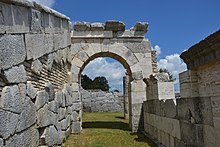

The Italic peoples were an ethnolinguistic group identified by use of Italic languages. Among the Italic peoples in the Italian peninsula were the Osci, the Veneti, the Samnites, the Latins and the Umbri.[39]
In the region south of the Tiber (Latium Vetus), the Latial culture of the Latins emerged, while in the north-east of the peninsula the Este culture of the Veneti appeared. Roughly in the same period, from their core area in central Italy (modern-day Umbria and Sabina), the Osco-Umbrians began to emigrate in various waves, through the process of Ver sacrum, the ritualized extension of colonies, in southern Latium, Molise and the whole southern half of the peninsula, replacing the previous tribes, such as the Opici and the Oenotrians. This corresponds with the emergence of the Terni culture, which had strong similarities with the Celtic cultures of Hallstatt and La Tène.[40]
Before and during the period of the arrival of the Greek and Phoenician immigrants, Sicily was already inhabited by native Italics in three major groups: the Elymians in the west, the Sicani in the centre, and the Sicels (source of the name Sicily) in the east.[41]
It is generally believed that around 2000 BC, the Ligures occupied a large area of the peninsula, including much of north-western Italy and all of northern Tuscany. Since many scholars consider the language of this ancient population to be Pre-Indo-European, they are often not classified as Italics.[42]
By the mid-first millennium BCE, the Latins of Rome were growing in power and influence. After the Latins had liberated themselves from Etruscan rule they acquired a dominant position among the Italic tribes. Frequent conflict between various Italic tribes followed; the best documented are the Samnite Wars.[43] The Latins eventually succeeded in unifying the Italic elements in the country. In the early first century BCE, several Italic tribes, in particular the Marsi and the Samnites, rebelled against Roman rule (the Social War). After Roman victory was secured, all peoples in Italy, except for the Celts of the Po Valley, were granted Roman citizenship. In the subsequent centuries, Italic tribes adopted Latin language and culture in a process known as Romanization.[43]
Magna Graecia
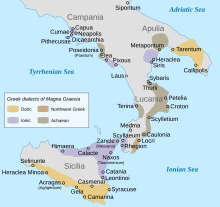
In the eighth and seventh centuries BC, for reasons including demographic crisis, the search for new commercial outlets and ports, and expulsion from their homeland, Greeks began to settle along the coast of Sicily and the southern part of the Italian peninsula, which became known as Magna Graecia.[45]
Greek culture was exported to Italy, in its dialects of the Ancient Greek language, its religious rites and its traditions of the independent polis. An original Hellenic civilization soon developed, later interacting with the native Italic and Latin civilisations. The most important cultural transplant was the Chalcidean/Cumaean variety of the Greek alphabet, which was adopted by the Etruscans; the Old Italic alphabet subsequently evolved into the Latin alphabet.
Many of the new Hellenic cities became very rich and powerful, like Neapolis (Naples), Syracuse, Acragas, and Sybaris. Other cities in Magna Graecia included Tarentum, Epizephyrian Locri, Rhegium, Croton, Thurii, Elea, Nola, Ancona, Syessa, Bari, and others.
After Pyrrhus of Epirus failed to stop the spread of Roman hegemony in 282 BC, the south fell under Roman domination. It was held by the Byzantine Empire after the fall of Rome in the West and even the Lombards failed to consolidate it, though the centre of the south was theirs from Zotto's conquest in the final quarter of the 6th century.[46]
Roman period
Roman Kingdom
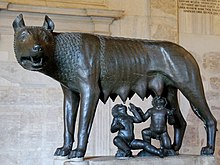
Little is certain about the history of the Roman Kingdom, as nearly no written records from that time survive, and the histories written during the Republic and Empire are largely based on legends. According to the founding myth of Rome, the city was founded on 21 April 753 BC by twin brothers Romulus and Remus, who descended from the Trojan prince Aeneas[47] and who were grandsons of Numitor of Alba Longa.
The traditional account of Roman history, which has come down through Livy, Plutarch, Dionysius of Halicarnassus, and others, is that in Rome's first centuries, it was ruled by a succession of seven kings. The Gauls destroyed much of Rome's historical records when they sacked the city after the Battle of the Allia in 390 or 387 BC. With no contemporary records, all accounts of the kings must be carefully evaluated.[48]
Roman Republic

According to tradition and later writers such as Livy, the Roman Republic was established around 509 BC,[49] when the last of the seven kings of Rome, Tarquin the Proud, was deposed by Lucius Junius Brutus. A system based on annually elected magistrates and various representative assemblies was established.[50] A constitution set a series of checks and balances, and a separation of powers. The most important magistrates were the two consuls, who together exercised executive authority as imperium, or military command.[51] The consuls had to work with the senate, which was initially an advisory council of the ranking nobility, or patricians, but grew in size and power.[52]
In the 4th century BC, the Republic came under attack by the Gauls, who initially prevailed and sacked Rome. The Romans then drove the Gauls back, led by Camillus. The Romans gradually subdued the other peoples on the peninsula.[53] The last threat to Roman hegemony in Italy came when Tarentum, a major Greek colony, enlisted the aid of Pyrrhus of Epirus in 281 BC, but this effort failed.[54][55]
In the 3rd century BC, Rome had to face a new and formidable opponent: Carthage. In the three Punic Wars, Carthage was eventually destroyed and Rome gained control over Hispania, Sicily and North Africa. After defeating the Macedonian and Seleucid Empires in the 2nd century BC, the Romans became the dominant people of the Mediterranean.[56][57] The conquest of the Hellenistic kingdoms provoked a fusion between Roman and Greek cultures and the Roman elite, once rural, became a luxurious and cosmopolitan one. By this time Rome was a consolidated empire – in the military view – and had no major enemies. Roman armies occupied Spain in the early 2nd century BC but encountered stiff resistance. The Celtiberian stronghold of Numantia became the centre of Spanish resistance in the 140s and 130s BC.[58] Numantia fell and was razed to the ground in 133 BC. In 105 BC, the Celtiberians drove the Cimbri and Teutones from northern Spain,[59] though these had crushed Roman arms in southern Gaul, inflicting 80,000 casualties on the Roman army. The conquest of Hispania was completed in 19 BC—but at a heavy cost.[60]

Towards the end of the 2nd century BC, a huge migration of Germanic tribes took place, led by the Cimbri and the Teutones. These tribes overwhelmed the peoples with whom they came into contact and threatened Italy. At the Battle of Aquae Sextiae and the Battle of Vercellae the Germans were virtually annihilated. In these two battles the Teutones and Ambrones are said to have lost 290,000 men, and the Cimbri 220,000.[61]
In the mid-1st century BC, the Republic faced a period of political crisis and social unrest. Julius Caesar reconciled the two more powerful men in Rome: Marcus Licinius Crassus and Pompey.[62] In 53 BC, the Triumvirate disintegrated at the death of Crassus. After being victorious in the Gallic Wars , Caesar crossed the Rubicon and invaded Rome in 49 BC, rapidly defeating Pompey. Caesar was eventually granted a dictatorship for perpetuity but was murdered in 44 BC.[63] Caesar's assassination caused political and social turmoil; without the dictator's leadership, Rome was ruled by his friend and colleague, Mark Antony. Octavian (Caesar's adopted son), along with Antony and Marcus Aemilius Lepidus,[64] established the Second Triumvirate. Lepidus was forced to retire in 36 BC after betraying Octavian in Sicily. Antony settled in Egypt with his lover, Cleopatra VII, which was seen as an act of treason.[65]
Following Antony's Donations of Alexandria, which gave Cleopatra the title of "Queen of Kings", and to their children the regal titles to the newly conquered Eastern territories, war between Octavian and Mark Antony broke out. Octavian annihilated Egyptian forces in the Battle of Actium in 31 BC. Mark Antony and Cleopatra committed suicide. Rome thus possessed unchallenged naval supremacy in the North Sea, Atlantic coasts, Mediterranean, Red Sea, and the Black Sea.
Roman Empire
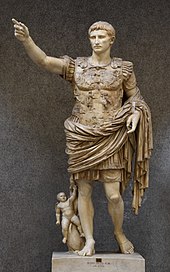
Octavian's leadership brought the zenith of the Roman civilization, which lasted for four decades. His adoption of the name Augustus in 27 BC is usually taken by historians as the beginning of the Roman Empire. Officially, the government was republican, but Augustus assumed absolute powers.[67][68] The Senate granted Octavian a unique grade of Proconsular imperium, which gave him authority over all Proconsuls (military governors).[69] The unruly imperial provinces at the borders, where the vast majority of the legions were stationed, were under the control of Augustus. The peaceful senatorial provinces were under the control of the Senate. The Roman legions, which had reached an unprecedented number (around 50) because of the civil wars, were reduced to 28.[70]
As provinces were being established throughout the Mediterranean, Roman Italy maintained a special status which made it Domina Provinciarum ("ruler of the provinces"),[71][72][73] and – especially in relation to the first centuries of imperial stability – Rectrix Mundi ("governor of the world")[74][75] and Omnium Terrarum Parens ("parent of all lands").[76][77] Such a status meant that, within Italy in times of peace, Roman magistrates exercised the Imperium domi (police power) as an alternative to the Imperium militiae (military power). Italy's inhabitants had Latin Rights as well as religious and financial privileges.

Roman literature grew steadily in the Golden Age of Latin Literature, with poets like Vergil, Horace, Ovid and Rufus. Augustus also continued the shifts on the calendar promoted by Caesar, and the month of August is named after him.[78] Augustus' enlightened rule resulted in 200 years of peace for the Empire, known as Pax Romana.[79]
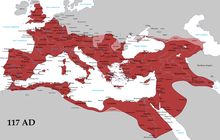
Despite its military strength, the Empire made few efforts to expand, the most notable being the conquest of Britain, begun by emperor Claudius (47), and emperor Trajan's conquest of Dacia (101–102, 105–106). In the 1st and 2nd centuries, Roman legions were also employed in intermittent warfare with the Germanic tribes to the north and the Parthian Empire to the east. Meanwhile, armed insurrections (e.g. the Hebraic insurrection in Judea, 70) and brief civil wars (e.g. in 68 AD the year of the four emperors) demanded the legions' attention. The seventy years of Jewish–Roman wars in the second half of the 1st century and the first half of the 2nd century were exceptional in their duration and violence.[80] An estimated 1,356,460 Jews were killed as a result of the First Jewish Revolt;[81] the Second Jewish Revolt (115–117) led to the death of more than 200,000 Jews;[82] and the Third Jewish Revolt (132–136) resulted in the death of 580,000 Jewish soldiers.[83]
After the death of Theodosius I (395), the Empire was divided into an Eastern and a Western Roman Empire. The Western part faced increasing economic and political crises and frequent barbarian invasions, so the capital was moved from Mediolanum to Ravenna. In 476, the last Western Emperor Romulus Augustulus was deposed by Odoacer.
Middle Ages
Odoacer's rule ended when the Ostrogoths, under the leadership of Theodoric, conquered Italy. Decades later, the armies of Eastern Emperor Justinian entered Italy with the goal of re-establishing imperial Roman rule, which led to the Gothic War that devastated the whole country with famine and epidemics. This ultimately allowed another Germanic tribe, the Lombards, to take control over vast regions of Italy. In 751 the Lombards seized Ravenna, ending Byzantine rule in northern Italy. Facing a new Lombard offensive, the Papacy appealed to the Franks for aid.[84]

In 756 Frankish forces defeated the Lombards and gave the Papacy legal authority over much of central Italy, establishing the Papal States. In 800, Charlemagne was crowned emperor of the Holy Roman Empire. After the death of Charlemagne (814), the new empire disintegrated under his weak successors, resulting in a power vacuum in Italy and coinciding with the rise of Islam in North Africa and the Middle East. In the South, there were attacks from the Umayyad Caliphate and the Abbasid Caliphate. In the North, there was a rising power of communes. In 852, the Saracens took Bari and founded an emirate there. Islamic rule over Sicily was effective from 902.
In the 11th century, trade slowly recovered as the cities started to grow again and the Papacy regained its authority. The Investiture controversy, over whether secular authorities had any legitimate role in appointments to ecclesiastical offices, was resolved by the Concordat of Worms in 1122, although problems continued in many areas of Europe until the end of the medieval era. In the north, a Lombard League of communes launched a successful effort to win autonomy from the Holy Roman Empire, defeating Emperor Frederick Barbarossa at the Battle of Legnano in 1176. In the south, the Normans occupied the Lombard and Byzantine possessions.[85] The few independent city-states were also subdued. During the same period, the Normans ended Muslim rule in Sicily. In 1130, Roger II of Sicily began his rule as the first king of the Norman Kingdom of Sicily; he had succeeded in uniting all the Norman conquests in Southern Italy into one kingdom with a strong centralized government. In 1155, Emperor Manuel Komnenos attempted to regain Southern Italy, but the attempt failed and in 1158 the Byzantines left Italy. The Norman Kingdom lasted until 1194 when Sicily was claimed by the German Hohenstaufen Dynasty.
Between the 12th and 13th centuries, Italy developed a peculiar political pattern, significantly different from feudal Europe north of the Alps. The oligarchic city-state became the prevalent form of government. Keeping direct Church control and Imperial power at arm's length, the many independent city-states prospered through commerce, ultimately creating the conditions for the artistic and intellectual changes produced by the Renaissance.[86][87] Northern cities and states were notable for their merchant republics, especially the Republic of Venice.[88] Compared to feudal and absolute monarchies, the merchant republics enjoyed relative political freedom.[89]
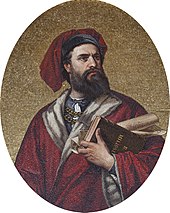
During this period, many Italian cities developed republican forms of government, such as the republics of Florence, Lucca, Genoa, Venice and Siena. During the 13th and 14th centuries these cities became major financial and commercial centres.[91] Milan, Florence and Venice, among other city-states, played a crucial innovative role in financial development, devising the main instruments and practices of banking and new forms of social and economic organization.[89]
Zdroj:https://en.wikipedia.org?pojem=History_of_Italy
>Text je dostupný pod licencí Creative Commons Uveďte autora – Zachovejte licenci, případně za dalších podmínek. Podrobnosti naleznete na stránce Podmínky užití.
Text je dostupný za podmienok Creative
Commons Attribution/Share-Alike License 3.0 Unported; prípadne za ďalších
podmienok.
Podrobnejšie informácie nájdete na stránke Podmienky
použitia.







